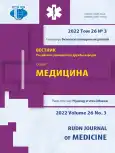Suprascapular notch morphometric study
- 作者: Chawla M.1, Sinsinwar P.2, Mishra A.3, Sorout J.4, Rao A.4
-
隶属关系:
- Alfalah school of medical science and research centre
- Yogita Dental College and hospital
- Kanti Devi Medical College and Hospital
- Rajasthan University of Health Sciences College of Medical Sciences
- 期: 卷 26, 编号 3 (2022): PHYSIOLOGY OF STRESS INFLUENCES
- 页面: 338-343
- 栏目: ANATOMY. PATHOLOGICAL ANATOMY
- URL: https://journal-vniispk.ru/2313-0245/article/view/319633
- DOI: https://doi.org/10.22363/2313-0245-2022-26-3-338-343
- ID: 319633
如何引用文章
全文:
详细
Relevance. The suprascapular notch is one of the most crucial areas of the scapula from a clinical standpoint. Aside from its anatomical relevance, the suprascapular notch type may also have some clinical implications for suprascapular nerve entrapment. Aim of the study was the determination of the different dimensions of the suprascapular notch based on the maximum depth (MD) and superior transverse diameter (STD), as well as the clinical relation between those dimensions and suprascapular nerve entrapment. Materials and Methods. The study’s materials were 100 unknown dry human scapulae from the from the anatomy department of the Mahatma Gandhi Medical College, Sitapura, Jaipur, Rajasthan. Each scapula was studied for suprascapular notch. From each of the scapulae, maximum depth and superior transverse diameter were determined. Fifty were from right side and Fifty were from left side. Different types of suprascapular notches were observed based on maximum depth and superior transverse diameter. Results and Discussion. In this study, the overall percentage distribution frequency of the suprascapular notch in 100 scapulae is MD > STD (25 %), MD = STD (0 %), STD > MD (60 %) and SSN Absent (15 %) respectively. The most common SSN type is STD > MD (60 %) type and least common SSN type is MD = STD (0 %) type. Conclusion. Morphological examination of the scapular notch reveals a common site of nerve compression and also demonstrates the surgical importance of the scapular nerve during shoulder surgery.
作者简介
Maheshwar Chawla
Alfalah school of medical science and research centre
Email: jitendersorout123@gmail.com
ORCID iD: 0000-0001-7738-7811
Dhauj, Faridabad, Hariyana, India
Pankaj Sinsinwar
Yogita Dental College and hospital
Email: jitendersorout123@gmail.com
ORCID iD: 0000-0002-8806-947X
Khed, Ratnagiri, Maharashtra, India
Abhibhusan Mishra
Kanti Devi Medical College and Hospital
Email: jitendersorout123@gmail.com
ORCID iD: 0000-0002-3448-6569
Mathura, Uttarpradesh, India
Jitender Sorout
Rajasthan University of Health Sciences College of Medical Sciences
编辑信件的主要联系方式.
Email: jitendersorout123@gmail.com
ORCID iD: 0000-0002-1510-0982
Jaipur, Rajasthan, India
Aayushee Rao
Rajasthan University of Health Sciences College of Medical Sciences
Email: jitendersorout123@gmail.com
ORCID iD: 0000-0002-0343-5777
Jaipur, Rajasthan, India
参考
- Rengachary SS, Burr D, Lucas S, Hassanein KM, Mohn MP, Matzke H. Suprascapular entrapment neuropathy: a clinical, anatomical, and comparative study. Part 2: anatomical study. Neurosurgery. 1979;5:447-451.
- Rengachary SS, Neff JP, Singer PA, Brackett CF. Suprascapular entrapment neuropathy: a clinical, anatomical, and comparative study. Part 1: clinical study. Neurosurger. 1979;5:441-446.
- Iannotti JP, Gabriel JP, Schneck SL, Evans BG, Misra S. The normal glenohumeral relationships. An anatomical study of one hundred and forty shoulders. J Bone Joint Surg Am. 1992;74:491500.
- Mallon WJ, Brown HR, Vogler JB 3rd, Martinez S. Radiographic and geometric anatomy of the scapula. Clinical orthopedics. 1992;277:142-154.
- Łabętowicz P, Synder M, Wojciechowski M, Orczyk K, Jezierski H, Topol M, Polguj M. Protective and Predisposing Morphological Factors in Suprascapular Nerve Entrapment Syndrome: A Fundamental Review Based on Recent Observations. Biomed Res Int. 2017;2017:4659761.
- Thompson WA, Kopell HP. Peripheral entrapment neuropathies of the upper extremity. N Engl J Med. 1959;260(25):1261-5.
- Rengachary SS, Burr D, Lucas S, Hassanein KM, Mohn MP, Matzke H. Suprascapular entrapment neuropathy: a clinical, anatomical, and comparative Study. Part 2: anatomical study. Neurosurgery. 1979;5(4):447-451.
- Kannan U, Kannan NS, Anbalagan J, Rao S. Morphometric study of suprascapular notch in Indian dry scapulae with specific reference to the incidence of completely ossified superior transverse scapular ligament. J Clin Diagn Res. 2014;8(3):7-10.
- Natsis K, Totlis T, Tsikaras P, Appell HJ, Skandalakis P, Koebke J. Proposal for classification of the suprascapular notch: a study on 423 dried scapulas. Clin Anat. 2007;20(2):135-139.
- Sinkeet SR, Awori KO, Odula PO, Ogeng’o JA, Mwachaka PM. The suprascapular notch: its morphology and distance from the glenoid cavity in a Kenyan population. Folia Morphol (Warsz). 2010; 69(4):241-245.
- Sangam MR. A Study on the Morphology of the Suprascapular Notch and Its Distance from the Glenoid Cavity. J Clin Diagn Res. 2013;7(2):189-192.
- Urgüden M, Ozdemir H, Dönmez B, Bilbaşar H, Oğuz N. Is there any effect of suprascapular notch type in iatrogenic suprascapular nerve lesions? An anatomical study. Knee Surg Sports Traumatol Arthrosc. 2004;12(3):241-5.
- Wang HJ, Chen C, Wu LP, Pan CQ, Zhang WJ, Li YK. Variable morphology of suprascapular notch: an investigation and quantitative measurements in Chinese population. Clin Anat. 2011;24:47-55.
- Apurba Patra, Manjeet Singh, Harsimarjit Kaur. Variations in the Shape and Dimension of the Suprascapular Notch in Dried Human Scapula-An Osteological Study with its Clinical Implications. International Journal of Anatomy, Radiology and Surgery, 2016;5(2) 1-5.
- Kumar A, Sharma A, Singh P. Anatomical study of the suprascapular notch: quantitative analysis and clinical considerations for suprascapular nerve entrapment. Singapore Med J. 2014;55(1):41-4.
- Daripelli S, Tolupunoori B, Vinodini L. Morphometric Study of Suprascapular Notch and Its Safe Zone in Indian Population. Maedica (Bucur). 2020;15(4):461-467.
- Warner JJP, Krushell RJ, Masquelet A, Gerber C. Anatomy and relationships of suprascapular nerve: anatomical constraints to mobilization of the supraspinatus and infraspinatus muscles in management of massive rotator-cuff tears. J Bone Joint Surg Am. 1992;74:36-45.
- De Mulder K, Marynissen H, Van Laere C. Arthroscopic transglenoid suture of Bankart lesions. Acta Orthop Belg. 1998;64:160-166.
- Bigliani LU, Dalsey RM, Mc Cann PD, April EW. An anatomical study of suprascapular nerve. Arthroscopy. 1990;6:301-305.
- M Venkata Raga Mayuri, T Naveen Sagar. The suprascapular notch: its morphology morphometry and clinical significance. Int J Anat Res. 2020;8(1.1):7237-7240.
补充文件









